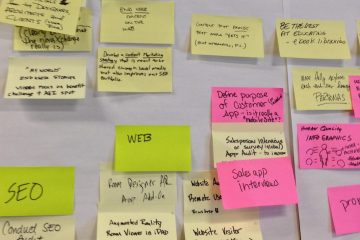Artificial Intelligence (AI) tools present huge opportunities for marketers to improve what they do and how they do it. Whether saving time and resources, developing more targeted and effective ads, or uncovering possibilities buried in avalanches of data, marketers employing AI have much to gain. The implementation of AI-powered solutions can generate opportunities for companies to differentiate, gain a competitive advantage, and improve customer experiences.
While recognizing the potential of AI, many marketers (particularly B2B) aren’t completely comfortable handing over decisions to machines. Yet in our daily lives we have already relinquished power in so many ways whether it is the next song to play or recommended product to buy. A recent HubSpot survey reported that 63% of people don’t realize they’re already using AI technologies. It’s everywhere and if you are talking about data-driven marketing, you need to be considering applications for AI.
Where and how do you start? With all the hype and robot hyperbole, it can seem daunting—and downright undoable for resource-constrained teams. No longer just for enterprise level companies, AI solutions have become affordable and accessible to marketers of all sizes and levels. Here are some ideas for ways to start putting artificial intelligence to work for you.
8 Ways to Apply AI in Marketing
1. Less digital grunt work
Faster, better, and cheaper than your intern (okay, not cheaper), machine learning and AI can handle digital data grunt work. These tools can work together to more effectively gather, process and learn from big data. Handing off the hard data-crunching and manual, time-intensive research tasks to machines means more time and focus can be allocated to where input from humans is needed. Researchers and marketers can spend less time analyzing what happened and more on why—and determining a plan for what to do in response.
2. Better data-mining across sources
There are so many data sources, tools, and technology software services available, integrating insights across all of them is not easy. AI can be used aggregate outputs and data from disparate sources to find patterns and provide marketers an integrated view.Frustrated by data silos? Wish all your marketing data was in one repository, easy to search and compile? Billed as “Marketing’s Cognitive Companion,” Lucy could be your best friend. Powered by Watson’s data-mining capabilities, Lucy can analyze structured and unstructured data from internal and external sources to simplify time-consuming research, planning, and segmentation tasks. From Word document white papers to PDFs and PowerPoints, Lucy can search, read, and analyze various document formats along with licensed service data.
3. Automated content generation
As the costs of human labor rise, automated content generation is an appealing alternative. Data and analytical information can be processed into natural language, assembled and delivered autonomously. Publishers and agencies have been using machine learning composition engines to produce commercial, creative, and editorial content for business reports, news stories, press releases, financial information (P&L, stocks), and emails. More creative tasks, such as picking ad music or slicing together the most engaging video clips, are also falling to AI and fewer people may be needed to generate this content in the future. (Don’t get too excited; you’ll still have to chase engineering for white paper content.)
4. Media buying and optimization
Digital media buying done automatically using AI marketing platforms requires little human interaction. Using a combination of natural language process, deep learning, predictive analytics, and algorithms, tools like Albert (AI intelligence marketing platform) monitor, bid, detect patterns, and adjust and optimize real-time across channels and devices. Bet your killer media planning Excel spreadsheet can’t do all that.
5. Personalized marketing—and better CRO
Engagement rates increase when ads are personalized, and customers expect relevancy with every interaction. Delivering personalized messages leads to less guessing and more conversions. The best content, recommendations, and offers can be presented to target audiences based upon the analysis of hundreds of customer data points (location, device, demographic, browsing history, content interactions, etc.) The information delivered is tailored to an individual user’s behaviors and data markers—making it relevant instead of intrusive.While personalization can include everything from dynamic banner ads and website landing pages to product recommendations, email is also a great place for b2b marketers to put algorithms to work. By analyzing subscriber’s previous behaviors, your next newsletter can be more personal, engaging, and sent at the ideal time to get noticed.
6. Social media match-making and monitoring
Brands are turning to social media influencers to enhance their campaigns, and some are applying data and technology to help with the match-making process. Influential is a platform that leverage’s IBM Watson to match brands with influencers on Facebook, Instagram, Twitter, Snapchat and YouTube. The pain of finding the ideal representative for a brand is made easier with AI and machine learning.If you aren’t looking for a spokesperson, you may want to know who is talking about what, how much, and when. Social media listing tools and Watson analytics can be used to monitor, retrieve, and analyze conversations about topics, brands, products/services, and events.
7. Lead identification and scoring
Analytics become actionable with AI-based algorithms that identify patterns in data about prospective companies and customers. Publicly accessible information about businesses and employee’s digital footprints can be gathered, analyzed, and categorized by market, product or service space. These predictive analytics can be used to identify and score marketing and sales leads and opportunities.
8. Chatbots
Chatbots can save money, time, and make an online experience easier and better for users. (If the chatbot is well designed and executed.) Implementations can range from customer service applications handling inquiries and requests to gathering information about a user’s preferences. Beyond providing services to users, chat conversation logs and actions are a great data source to understand customer’s needs, terminology, and search context. Every interaction with a customer is a chance to research how to improve the bot or other customer interactions.
Tie AI to ROI
When considering how to use AI to support a marketing program and resources, don’t fall prey to the shiny new toy syndrome. (Your website doesn’t need a joke telling weather bot.) Identify a problem that the technology can help solve and implement it in a way that has purpose, value, or clear benefits. If it will make something easier, more effective, or provide an ROI, then you know it is an intelligent decision.

